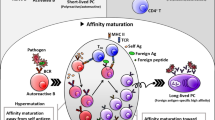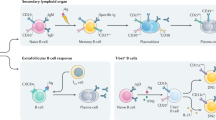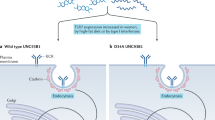Abstract
B lymphocytes contribute to immunity through organogenesis of secondary lymphoid organs, presentation of antigen to T cells, production of antibodies, and secretion of cytokines. Their roles in autoimmune diseases are complex. Clinical trials have shown that depleting B cells can significantly ameliorate such diseases, underlining the contributions of B cells to pathogenesis. Conversely, B-cell depletion can lead to exacerbation of symptoms in some patients. In mice, B cells can offer protection from chronic autoimmune pathologies. It is important to understand the mechanisms responsible for the distinct roles of B cells in autoimmune diseases, and investigation of these processes could highlight new therapeutic strategies. Here, we review recent progress in our understanding of the suppressive functions of activated B cells in mice, as well as the promising potential of B cells for use as cell-based therapy for experimental autoimmune diseases, and, finally, discuss the possibility of translating this cellular approach to treat human autoimmune diseases.
Key Points
-
B cells can have not only pathogenic but also protective roles in human autoimmune diseases
-
Activated B cells can suppress autoimmune diseases in mice
-
Interleukin-10 production by B cells is an important mediator of the suppressive functions of B cells
-
B cells can suppress autoimmune diseases by interacting with multiple immune mechanisms
-
B cells are interesting candidates for cell-based therapy of autoimmune diseases
This is a preview of subscription content, access via your institution
Access options
Subscribe to this journal
Receive 12 print issues and online access
$209.00 per year
only $17.42 per issue
Buy this article
- Purchase on Springer Link
- Instant access to full article PDF
Prices may be subject to local taxes which are calculated during checkout


Similar content being viewed by others
References
Edwards JC et al. (2004) Efficacy of B-cell-targeted therapy with rituximab in patients with rheumatoid arthritis. N Engl J Med 350: 2572–2581
Hauser SL et al. (2008) B-cell depletion with rituximab in relapsing–remitting multiple sclerosis. N Engl J Med 358: 676–688
Goetz M et al. (2007) Exacerbation of ulcerative colitis after rituximab salvage therapy. Inflamm Bowel Dis 13: 1365–1368
Broglio L and Lauria G (2005) Worsening after rituximab treatment in anti-mag neuropathy. Muscle Nerve 32: 378–379
Renaud S et al. (2003) Rituximab in the treatment of polyneuropathy associated with anti-MAG antibodies. Muscle Nerve 27: 611–615
Benedetti L et al. (2007) Relapses after treatment with rituximab in a patient with multiple sclerosis and anti myelin-associated glycoprotein polyneuropathy. Arch Neurol 64: 1531–1533
Fassi DE et al. (2008) Ulcerative colitis following B lymphocyte depletion with rituximab in a patient with Graves' disease. Gut 57: 714–715
Svensson L et al. (1998) B cell-deficient mice do not develop type II collagen-induced arthritis (CIA). Clin Exp Immunol 111: 521–526
Serreze DV et al. (1996) B lymphocytes are essential for the initiation of T cell-mediated autoimmune diabetes: analysis of a new “speed congenic” stock of NOD.Igmu null mice. J Exp Med 184: 2049–2053
Lyons JA et al. (1999) B cells are critical to induction of experimental allergic encephalomyelitis by protein but not by a short encephalitogenic peptide. Eur J Immunol 29: 3432–3439
Hu CY et al. (2007) Treatment with CD20-specific antibody prevents and reverses autoimmune diabetes in mice. J Clin Invest 117: 3857–3867
Ahuja A et al. (2007) Depletion of B cells in murine lupus: efficacy and resistance. J Immunol 179: 3351–3361
Wolf SD et al. (1996) Experimental autoimmune encephalomyelitis induction in genetically B cell-deficient mice. J Exp Med 184: 2271–2278
Mizoguchi A et al. (1997) Suppressive role of B cells in chronic colitis of T cell receptor alpha mutant mice. J Exp Med 186: 1749–1756
Fillatreau S et al. (2002) B cells regulate autoimmunity by provision of IL-10. Nat Immunol 3: 944–950
Lyons JA et al. (2008) B cells limit epitope spreading and reduce severity of EAE induced with PLP peptide in BALB/c mice. J Autoimmun 31: 149–155
Mizoguchi A et al. (2002) Chronic intestinal inflammatory condition generates IL-10-producing regulatory B cell subset characterized by CD1d upregulation. Immunity 16: 219–230
Mauri C et al. (2003) Prevention of arthritis by interleukin 10-producing B cells. J Exp Med 197: 489–501
Duddy ME et al. (2004) Distinct profiles of human B cell effector cytokines: a role in immune regulation. J Immunol 172: 3422–3427
Duddy M et al. (2007) Distinct effector cytokine profiles of memory and naive human B cell subsets and implication in multiple sclerosis. J Immunol 178: 6092–6099
Mizoguchi E et al. (2000) Regulatory role of mature B cells in a murine model of inflammatory bowel disease. Int Immunol 12: 597–605
Skupsky J et al. (2007) Tolerance induction by gene transfer to lymphocytes. Curr Gene Ther 7: 369–380
Hussain S and Delovitch TL (2007) Intravenous transfusion of BCR-activated B cells protects NOD mice from type 1 diabetes in an IL-10-dependent manner. J Immunol 179: 7225–7232
Fillatreau S et al. (2008) Not always the bad guys: B cells as regulators of autoimmune pathology. Nat Rev Immunol 8: 391–397
Lampropoulou V et al. (2008) TLR-activated B cells suppress T cell-mediated autoimmunity. J Immunol 180: 4763–4773
Barr TA et al. (2007) TLR-mediated stimulation of APC: distinct cytokine responses of B cells and dendritic cells. Eur J Immunol 37: 3040–3053
Prinz M et al. (2006) Innate immunity mediated by TLR9 modulates pathogenicity in an animal model of multiple sclerosis. J Clin Invest 116: 456–464
Bach JF (2002) The effect of infections on susceptibility to autoimmune and allergic diseases. N Engl J Med 347: 911–920
Tian J et al. (2001) Lipopolysaccharide-activated B cells down-regulate Th1 immunity and prevent autoimmune diabetes in nonobese diabetic mice. J Immunol 167: 1081–1089
Shimomura Y et al. (2008) Regulatory role of B-1 B cells in chronic colitis. Int Immunol 20: 729–737
Croft M et al. (1997) Partial activation of naive CD4 T cells and tolerance induction in response to peptide presented by resting B cells. J Immunol 159: 3257–3265
Tony HP et al. (1985) Role of membrane immunoglobulin (Ig) crosslinking in membrane Ig-mediated, major histocompatibility-restricted T cell-B cell cooperation. J Exp Med 162: 1695–1708
Gosselin EJ et al. (1988) Characterization of antigen processing and presentation by resting B lymphocytes. J Immunol 140: 1408–1413
Eynon EE and Parker DC (1992) Small B cells as antigen-presenting cells in the induction of tolerance to soluble protein antigens. J Exp Med 175: 131–138
Day MJ et al. (1992) Targeting autoantigen to B cells prevents the induction of a cell-mediated autoimmune disease in rats. J Exp Med 175: 655–659
Saoudi A et al. (1995) Prevention of experimental allergic encephalomyelitis in rats by targeting autoantigen to B cells: evidence that the protective mechanism depends on changes in the cytokine response and migratory properties of the autoantigen-specific T cells. J Exp Med 182: 335–344
Fuchs EJ and Matzinger P (1992) B cells turn off virgin but not memory T cells. Science 258: 1156–1159
Chen C et al. (2001) A gene therapy approach for treating T-cell-mediated autoimmune diseases. Blood 97: 886–894
Melo ME et al. (2001) Gene therapeutic approaches to induction and maintenance of tolerance. Int Rev Immunol 20: 627–645
Zambidis ET and Scott DW (1996) Epitope-specific tolerance induction with an engineered immunoglobulin. Proc Natl Acad Sci USA 93: 5019–5024
Borel Y (1980) Haptens bound to self IgG induce immunologic tolerance, while when coupled to syngeneic spleen cells they induce immune suppression. Immunol Rev 50: 71–104
Kang Y et al. (1999) Induction of hyporesponsiveness to intact foreign protein via retroviral-mediated gene expression: the IgG scaffold is important for induction and maintenance of immune hyporesponsiveness. Proc Natl Acad Sci USA 96: 8609–8614
Kaufman DL et al. (1993) Spontaneous loss of T-cell tolerance to glutamic acid decarboxylase in murine insulin-dependent diabetes. Nature 366: 69–72
Melo ME et al. (2002) Gene transfer of Ig-fusion proteins into B cells prevents and treats autoimmune diseases. J Immunol 168: 4788–4795
Chen CC et al. (2004) Complete protection from relapsing experimental autoimmune encephalomyelitis induced by syngeneic B cells expressing the autoantigen. Blood 103: 4616–4618
Zambidis ET et al. (1997) Both resting and activated B lymphocytes expressing engineered peptide-Ig molecules serve as highly efficient tolerogenic vehicles in immunocompetent adult recipients. J Immunol 158: 2174–2182
Lei TC et al. (2005) Tolerance induction via a B-cell delivered gene therapy-based protocol: optimization and role of the Ig scaffold. Cell Immunol 235: 12–20
Bretscher P and Cohn M (1970) A theory of self-nonself discrimination. Science 169: 1042–1049
Janeway CA Jr (1989) Approaching the asymptote? Evolution and revolution in immunology. Cold Spring Harb Symp Quant Biol 54: 1–13
Matzinger P (1994) Tolerance, danger, and the extended family. Annu Rev Immunol 12: 991–1045
Medzhitov R et al. (1997) A human homologue of the Drosophila Toll protein signals activation of adaptive immunity. Nature 388: 394–397
Caux C et al. (1994) Activation of human dendritic cells through CD40 cross-linking. J Exp Med 180: 1263–1272
Moulin V et al. (2000) B lymphocytes regulate dendritic cell (DC) function in vivo: increased interleukin 12 production by DCs from B cell-deficient mice results in T helper cell type 1 deviation. J Exp Med 192: 475–482
Pasare C and Medzhitov R (2003) Toll pathway-dependent blockade of CD4+CD25+ T cell-mediated suppression by dendritic cells. Science 299: 1033–1036
Ding L and Shevach EM (1992) IL-10 inhibits mitogen-induced T cell proliferation by selectively inhibiting macrophage costimulatory function. J Immunol 148: 3133–3139
Gerth AJ et al. (2004) An innate cell-mediated, murine ulcerative colitis-like syndrome in the absence of nuclear factor of activated T cells. Gastroenterology 126: 1115–1121
Hahne M et al. (1996) Activated B cells express functional Fas ligand. Eur J Immunol 26: 721–724
Parekh V V et al. (2003) B cells activated by lipopolysaccharide, but not by anti-Ig and anti-CD40 antibody, induce anergy in CD8+ T cells: role of TGF-beta 1. J Immunol 170: 5897–5911
Raimondi G et al. (2006) Induction of peripheral T cell tolerance by antigen-presenting B cells. II. Chronic antigen presentation overrules antigen-presenting B cell activation. J Immunol 176: 4021–4028
Bouaziz JD et al. (2007) Therapeutic B cell depletion impairs adaptive and autoreactive CD4+ T cell activation in mice. Proc Natl Acad Sci USA 104: 20878–20883
Stasi R et al. (2007) Response to B-cell depleting therapy with rituximab reverts the abnormalities of T-cell subsets in patients with idiopathic thrombocytopenic purpura. Blood 110: 2924–2930
Cross AH et al. (2006) Rituximab reduces B cells and T cells in cerebrospinal fluid of multiple sclerosis patients. J Neuroimmunol 180: 63–70
Wakkach A et al. (2003) Characterization of dendritic cells that induce tolerance and T regulatory 1 cell differentiation in vivo. Immunity 18: 605–617
Gray M et al. (2007) Apoptotic cells protect mice from autoimmune inflammation by the induction of regulatory B cells. Proc Natl Acad Sci USA 104: 14080–14085
Akbari O et al. (2001) Pulmonary dendritic cells producing IL-10 mediate tolerance induced by respiratory exposure to antigen. Nat Immunol 2: 725–731
Ashour HM and Niederkorn JY (2006) Peripheral tolerance via the anterior chamber of the eye: role of B cells in MHC class I and II antigen presentation. J Immunol 176: 5950–5957
Wilbanks GA and Streilein JW (1990) Characterization of suppressor cells in anterior chamber-associated immune deviation (ACAID) induced by soluble antigen: evidence of two functionally and phenotypically distinct T-suppressor cell populations. Immunology 71: 383–389
D'Orazio TJ et al. (2001) Ocular immune privilege promoted by the presentation of peptide on tolerogenic B cells in the spleen. II. Evidence for presentation by Qa-1. J Immunol 166: 26–32
Keino H et al. (2006) CD8+ T regulatory cells use a novel genetic program that includes CD103 to suppress Th1 immunity in eye-derived tolerance. Invest Ophthalmol Vis Sci 47: 1533–1542
Jiang H and Chess L (2000) The specific regulation of immune responses by CD8+ T cells restricted by the MHC class Ib molecule, Qa-1. Annu Rev Immunol 18: 185–216
Wei B et al. (2008) Integration of B cells and CD8(+) T in the protective regulation of systemic epithelial inflammation. Clin Immunol 127: 303–312
Wei B et al. (2005) Mesenteric B cells centrally inhibit CD4+ T cell colitis through interaction with regulatory T cell subsets. Proc Natl Acad Sci USA 102: 2010–2015
Lee YH et al. (2008) Essential role of CD8+CD122+ regulatory T cells in the recovery from experimental autoimmune encephalomyelitis. J Immunol 180: 825–832
Mann MK et al. (2007) B cell regulation of CD4+CD25+ T regulatory cells and IL-10 via B7 is essential for recovery from experimental autoimmune encephalomyelitis. J Immunol 178: 3447–3456
Song L et al. (2004) Retroviral delivery of GAD-IgG fusion construct induces tolerance and modulates diabetes: a role for CD4+ regulatory T cells and TGF-beta. Gene Ther 11: 1487–1496
Soukhareva N et al. (2006) Treatment of diabetes in NOD mice by gene transfer of Ig-fusion proteins into B cells: role of T regulatory cells. Cell Immunol 240: 41–46
Agarwal RK et al. (2000) Retroviral gene therapy with an immunoglobulin-antigen fusion construct protects from experimental autoimmune uveitis. J Clin Invest 106: 245–252
Weir CR et al. (2002) Experimental autoimmune encephalomyelitis induction in naive mice by dendritic cells presenting a self-peptide. Immunol Cell Biol 80: 14–20
Dittel BN et al. (1999) Presentation of the self antigen myelin basic protein by dendritic cells leads to experimental autoimmune encephalomyelitis. J Immunol 163: 32–39
Matto M et al. (2006) hCAR-EGFP fusion receptor in human follicular lymphoma B cells—a model for adenoviral gene therapy for B cell malignancies. Int J Mol Med 17: 1057–1062
Hellebrand E et al. (2006) Epstein-Barr virus vector-mediated gene transfer into human B cells: potential for antitumor vaccination. Gene Ther 13: 150–162
Seiffert M et al. (2007) Efficient nucleofection of primary human B cells and B-CLL cells induces apoptosis, which depends on the microenvironment and on the structure of transfected nucleic acids. Leukemia 21: 1977–1983
Pasare C and Medzhitov R (2005) Control of B-cell responses by Toll-like receptors. Nature 438: 364–368
Bernasconi NL et al. (2003) A role for Toll-like receptors in acquired immunity: up-regulation of TLR9 by BCR triggering in naive B cells and constitutive expression in memory B cells. Blood 101: 4500–4504
Litzinger MT et al. (2005) Mechanisms of gene therapy for tolerance: B7 signaling is required for peptide-IgG gene-transferred tolerance induction. J Immunol 175: 780–787
El-Amine M et al. (2000) Mechanisms of tolerance induction by a gene-transferred peptide-IgG fusion protein expressed in B lineage cells. J Immunol 165: 5631–5636
Greenwald RJ (2001) CTLA-4 regulates induction of anergy in vivo. Immunity 14: 145–155
Acknowledgements
Work in the authors' laboratories is supported by the Deutsche Forschungsgemeinschaft (SFB-650), the Association pour la Recherche sur la Sclerose en Plaques (ARSEP), Hertie Stiftung (S Fillatreau), the UK Medical Research Council, The Wellcome Trust, and the UK Multiple Sclerosis Society (SM Anderton). SM Anderton is a Medical Research Council Senior Research Fellow and holds a Research Councils UK Fellowship in translational medicine.
Author information
Authors and Affiliations
Corresponding author
Ethics declarations
Competing interests
The authors declare no competing financial interests.
Rights and permissions
About this article
Cite this article
Anderton, S., Fillatreau, S. Activated B cells in autoimmune diseases: the case for a regulatory role. Nat Rev Rheumatol 4, 657–666 (2008). https://doi.org/10.1038/ncprheum0950
Received:
Accepted:
Issue Date:
DOI: https://doi.org/10.1038/ncprheum0950
This article is cited by
-
B cells in autoimmune hepatitis: bystanders or central players?
Seminars in Immunopathology (2022)
-
The pursuit of transplantation tolerance: new mechanistic insights
Cellular & Molecular Immunology (2019)
-
Negative IgG Varicella Zoster Virus Antibody Status: Immune Responses Pre and Post Re-immunization
Infectious Diseases and Therapy (2018)
-
Idiopathic retroperitoneal fibrosis and its overlap with IgG4-related disease
Internal and Emergency Medicine (2017)
-
Immune Tolerance Induction to Factor IX through B Cell Gene Transfer: TLR9 Signaling Delineates between Tolerogenic and Immunogenic B Cells
Molecular Therapy (2014)



